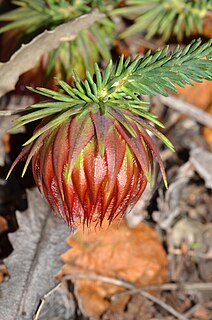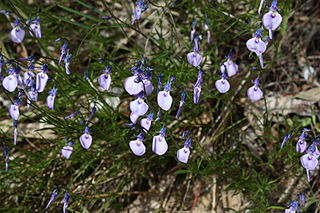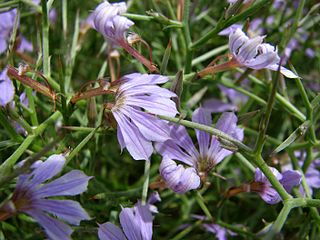
Olearia, most commonly known as daisy-bush, is a genus of flowering plants belonging to the family Asteraceae, the largest of the flowering plant families in the world. Olearia are found in Australia, New Guinea and New Zealand. The genus includes herbaceous plants, shrubs and small trees. The latter are unusual among the Asteraceae and are called tree daisies in New Zealand. All bear the familiar daisy-like composite flowerheads in white, pink, mauve or purple.

Floydia is a monotypic species of tree in the family Proteaceae native to Australia. It is a somewhat rare tree found only growing in the rainforests of southeastern Queensland and northern New South Wales. The sole species is Floydia praealta which is commonly known as the ball nut or possum nut.

Olearia teretifolia is an Australian plant in the genus Olearia. Its common name is cypress daisy-bush.
Grevillea annulifera, also known as prickly plume grevillea, is a shrub which is endemic to Western Australia. It grows to between 1 and 4 metres in height and produces white, cream or yellow flowers between June and October in its native range.

Grevillea endlicheriana, also known as spindly grevillea, is a shrub which is endemic to the southwest of Western Australia.

Hypocalymma xanthopetalum is a species of shrub in the myrtle family Myrtaceae, endemic to the south west region of Western Australia.

Darwinia neildiana, commonly known as fringed bell, is a shrub which is endemic to Western Australia. It grows to between 0.2 and 1 metre in height and produces red flowers between August and December in the species' native range. The species was first formally described by Victorian Government botanist Ferdinand von Mueller in 1875 in Fragmenta Phytographiae Australiae.

The flora of Western Australia comprises 10,252 published native vascular plant species and a further 1,245 unpublished species. They occur within 1,543 genera from 211 families; there are also 1,276 naturalised alien or invasive plant species more commonly known as weeds. There are an estimated 150,000 cryptogam species or nonvascular plants which include lichens, and fungi although only 1,786 species have been published, with 948 algae and 672 lichen the majority.

Olearia ramulosa, the twiggy daisy-bush, is a species of flowering plant in the family Asteraceae. It occurs in New South Wales, Victoria, South Australia and Tasmania.

Grevillea stenomera, commonly known as lace net grevillea, is a shrub in the family Proteaceae. It is endemic to Western Australia, occurring between Kalbarri and Tamala.

Hybanthus calycinus is a perennial herb of the violet family, Violaceae. The species is endemic to the south-west of Western Australia.

Pultenaea muelleri is a shrub which is endemic to Victoria, Australia. The species is a member of the family Fabaceae and of the genus Pultenaea. It is a dense shrub that can grow to between 1 and 3 metres in height. The leaves are 10 to 20 mm long, 1 to 2 mm wide and have parallel veins and soft hairs on the undersides. The pea-shaped flowers, which are produced in terminal heads, are yellow with a red centre. These appear between October and January in the species' native range.

Olearia megalophylla, the large-leaf daisy bush, is a species of flowering plant in the family Asteraceae. It is a shrub up to 2 metres high with scattered leaves. These are dark green above, woolly underneath, and are 20 to 120 mm long and 6 to 28 mm wide. The flower heads have 5 to 9 white ray florets and 9 to 14 yellow disc florets. The species was first formally described by Ferdinand von Mueller in Papers and Proceedings of the Royal Society of Tasmania in 1859 and named Eurybia megalophylla. In 1865, he placed the species in the genus Aster and finally in Olearia in 1867. It occurs in moist sclerophyll forest in south-eastern New South Wales and Victoria.

Grevillea confertifolia, commonly known as Grampians grevillea or dense-leaf grevillea, is a shrub species which is endemic to the Grampians in western Victoria, in Australia.
Grevillea brevifolia, commonly known as Cobberas grevillea, is a species of the plant genus Grevillea. It is native to the states of Victoria and New South Wales in Australia. The red flowers appear between November and December in the species' native range. The species was first formally described by Victorian Government Botanist Ferdinand von Mueller in 1879 in Flora Australiensis, based on a collection from Mount Tambo in Victoria. The former subspecies G. brevifolia subsp. polychroma was elevated to species status as Grevillea polychroma in 2005. Grevillea brevifolia is listed as "Rare in Victoria" in the Department of Environment and Primary Industries' Advisory List of Rare Or Threatened Plants In Victoria. The species occurs in sub-alpine areas including the Pilot Wilderness, the Cobberas-Tingaringy Unit of the Alpine National Park, and Mount Seldom Seen.
Corchorus walcottii, commonly known as woolly corchorus, is a shrub species in the family Malvaceae. It is endemic to Australia. Plants grow to 1.2 metres high and produce yellow flowers between June and November in the species' native range.

Olearia asterotricha, commonly known as rough daisy-bush, is a species of flowering plant in the family Asteraceae. A tall shrub with white, mauve or blue daisy like flowers growing from the Blue Mountains in New South Wales to western Victoria, Australia.
Grevillea stenobotrya is a shrub in the family Proteaceae. It is endemic to arid regions of Australia. Common names include rattle-pod grevillea, sandhill grevillea and sandhill spider flower. Plants grow to between 1.5 and 6 metres in height and have leaves are linear and entire, or occasionally divided, and between 6 and 28 cm long and 0.7 to 2.5 mm wide. Flowers are cream, pale yellow or pale pink. These appear in clustered spikes at the end of branches between May and December in the species' native range. The fruits which follow are hard, flattened and rounded and have a short beak.

Scaevola oxyclona, commonly known as tangled fanflower, is a spiny shrub in the family Goodeniaceae, native to Western Australia. It grows to between 0.1 and 1.5 metres high and produces blue to purple flowers from August to December in its native range. The species was first formally described in 1876 by Victorian Government Botanist Ferdinand von Mueller in the tenth volume of Fragmenta Phytographiae Australiae based on plant material collected at Frasers Range and Mount Benjamin.
Grevillea pterosperma, commonly known as desert grevillea or desert spider-flower, is a flowering plant species in the family Proteaceae, endemic to Australia.















